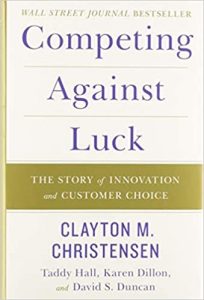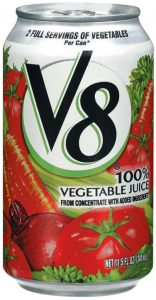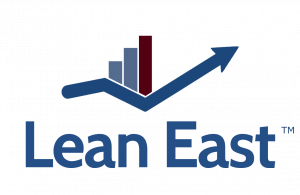Competing Against Luck is the 2016 story of innovation and customer choice by Clayton M. Christensen that introduces jobs theory.
Do you know why your most recent customer purchased your product or service? Not the obvious reason, but the deeper reason behind the choice?

For example, why do people buy milkshakes? Are you buying the milkshake to satisfy hunger?
As a dessert treat?
To cool you off on a hot day?
To appease your kids for a few minutes of peace and quiet?
Competing Against Luck
Clayton Christensen introduced the groundbreaking theory of disruptive innovation in his 1997 book The Innovator’s Dilemma. The concept (discussed by Lean East in this post) has been called the most influential business idea of the early 21st century. It also made Christensen one of the world’s top experts on innovation. The former Harvard Business School professor passed away in 2020, but his ideas and theories regarding innovation are critical for every business to understand.
 In one of his final books, Christensen collaborated with three other authors to write Competing Against Luck. The book introduces the innovative concept of Jobs Theory, a new way of thinking (related to design thinking) the authors believe will revolutionize innovation. Christensen notes that while it took eight years for him to develop and explain the concept of disruptive innovation, it took him “nearly two decades to hone the Jobs to Be Done Theory of marketing in this book.”
In one of his final books, Christensen collaborated with three other authors to write Competing Against Luck. The book introduces the innovative concept of Jobs Theory, a new way of thinking (related to design thinking) the authors believe will revolutionize innovation. Christensen notes that while it took eight years for him to develop and explain the concept of disruptive innovation, it took him “nearly two decades to hone the Jobs to Be Done Theory of marketing in this book.”
Before we discuss Jobs Theory, let’s return to the question of why we “hire” a milkshake.
Milkshake Example
Innovators have long been known to focus on understanding the customer’s reasons for buying their product or service. Consider a consumer who goes to a fast-food restaurant to buy a milkshake. When most people think of innovations in the product category of “milkshakes” they will imagine new flavors, ingredients, combinations of flavors, or serving methods. Enticing flavors may be a reason to keep buying a product, but they ignore the initial customer buying decision.
Consumers buy products and services to fulfill their needs – or jobs to be done – when the product or service is better than any of the alternatives. Different jobs to be done will have different alternative options. For example, if the job to be done is “cooling you off,” a few of the milkshake alternatives a consumer might “hire” for the job include water, iced tea, or a beer. This is a very different job than “quieting my 5-year-old in the backseat,” where alternatives might include a toy or a video screen.
The table below shows additional examples of “milkshake jobs to be done.” If you think back to the last time you ordered a milkshake you may be able to add additional hiring “jobs to be done” to this table.
| Milkshake “jobs to be done” | Alternatives (Competition) |
| Cooling off in the heat | Ice water, iced tea, cold beer |
| Something to drink while driving | Soda, coffee, water bottle |
| Help stay awake in the morning | Coffee, energy drink, soda, candy bar |
| Quick breakfast during the drive to work | Granola bar, banana, bagel, candy bar |
| A treat for dessert | Ice cream, cookie, cake, pie, candy |
| Occupying a child while you are driving | Game for phone, video screen, kid’s music |
| Feeling like a good parent | Attending an event or movie, reading together |
Jobs Theory
The Theory of Jobs to be Done is focused on understanding what causes customers to “hire” a product or service. This is a key part of a good Customer Discovery process as we describe in our post on Lean Startup Thinking. As you interview customers to discover their reasoning, there are several key questions to examine in the process:
-
Why do customers make the “Big Hire” of your product or service?
 The “big hire” is the initial customer decision to buy your product or service. This decision is made in the grocery store, at the clothing shop, in the online app store, when signing the service agreement, etc.
The “big hire” is the initial customer decision to buy your product or service. This decision is made in the grocery store, at the clothing shop, in the online app store, when signing the service agreement, etc.
Customers at this stage have made the decision to “fire” the alternative choice (on the shelf, in the closet, etc.) to do their job, but they haven’t done it yet. Companies often don’t think about what their customers have “fired” by using their product or service.
-
Why do customers make the “Little Hire” and use the product or service?
 The “little hire” is the customer’s decision to use your product or service. The little hire is when you consume the grocery store item, remove the tags and wear the outfit, use the new service, read the book, etc.
The “little hire” is the customer’s decision to use your product or service. The little hire is when you consume the grocery store item, remove the tags and wear the outfit, use the new service, read the book, etc.
How often have you waited to use a product or service and then were disappointed? How often have you never made the “little hire” decision and left the item on the shelf or never used it? If the product or service is successful at doing the customer’s job, they are more likely to hire it again.
-
What obstacles get in the customer’s way when hiring?
Jobs Theory requires a deep understanding of a customer’s real Job to be Done and their decision process. Where do your products and services fall short of perfectly nailing the jobs they were hired for?

Who is not consuming your products? How do their jobs differ from your current customers and what’s stopping these nonconsumers from using your product or service?
Christensen shares the example of the Segway – the two-wheeled, self-balancing, electric vehicle invented by Dean Kamen. The product was released with great fanfare and a prediction that it would “change transportation forever.” But what job does it do better than the alternatives?
Years later, most people consider the Segway a product flop. The Segway was a cool invention, but it didn’t solve a Job to Be Done that a lot of customers cared about.
We recommend customer discovery interviews focus more on the “little hire” decision rather than the initial purchase decision. Similarly, they should also learn what the customer previously used for their job that they “fired” in the process.
Innovate with Jobs Theory
-
Are your innovation efforts connected to the core jobs your company was started to solve?
When prioritizing areas to focus your innovation efforts, do not lose sight of the primary job(s) customers hire you for. It is easy for companies to get caught up in focusing on the products and services they offer instead of the jobs they solve.
 Christensen shares the example of Campbell’s V8 drink, made from eight different vegetables and first introduced in 1933. A focus on product innovation has led to new V8 products that compete against other drinks on taste. Spicy Hot V8, Lemon V8, and Picante V8 are sitting on the shelf next to bottled water, hydrating sports drinks, and sodas.
Christensen shares the example of Campbell’s V8 drink, made from eight different vegetables and first introduced in 1933. A focus on product innovation has led to new V8 products that compete against other drinks on taste. Spicy Hot V8, Lemon V8, and Picante V8 are sitting on the shelf next to bottled water, hydrating sports drinks, and sodas.
When seen through a Jobs lens, V8 doesn’t need to compete against these other flavors. What if it sits on the shelf next to vegetables? For people who don’t like to prepare and eat vegetables every night, they can drink V8 instead. If the job V8 is doing is “getting your recommended daily serving of vegetables,” then V8 is going to get hired a lot versus the alternative!
-
What is the most important job your organization exists to solve?
Most organizations have mission statements, but how many connect the mission and innovation strategy to the core jobs the organization was formed to solve? Do your employees characterize your organization in terms of solving an important job in your customers’ lives or in terms of the products and services you offer?
What data is driving your innovation and investment decisions? Don’t fall prey to the fallacy of surface growth – driving growth through selling new products to existing customers without an understanding of the progress they want to make in their lives. Does the “Voice of the Customer” have a say in your decision-making and resource allocation activities?
“Customers don’t want to buy a quarter-inch drill. They want to buy a quarter-inch hole.”
-
What are the important, unsatisfied jobs in the lives of both your customers and nonconsumers?
 Innovative new products and services (including disruptive innovations) are best discovered by focusing on unsatisfied jobs. For instance, areas where existing solutions don’t adequately solve a problem. Inventors often begin by focusing on unsatisfied jobs in their own lives and the lives of those closest to them. What are the circumstances of these jobs, and the functional, emotional, and social dimensions? Do innovation opportunities come to mind?
Innovative new products and services (including disruptive innovations) are best discovered by focusing on unsatisfied jobs. For instance, areas where existing solutions don’t adequately solve a problem. Inventors often begin by focusing on unsatisfied jobs in their own lives and the lives of those closest to them. What are the circumstances of these jobs, and the functional, emotional, and social dimensions? Do innovation opportunities come to mind?
What new jobs can your existing product or service solve for a consumer? Will a bit of incremental innovation solve the problem better? If so, there is a good chance these consumers will fire their previous solution and hire your product for the job.
Talk to both your customers and nonconsumers, discover their behaviors, and always keep your eyes on the job.
Customer Jobs Discovery
The work of Customer Discovery using Jobs Theory thinking allows businesses to improve their innovation track record. You will create products and services that customers not only want to hire but will pay premium prices to bring into their lives.
Take the time to better understand your customer and stop being frustrated by your hit-and-miss efforts at innovation!
Please share your comments about these ideas and concepts below, and feel free to contact Lean East for help applying Jobs Theory to your innovation process.


Related Posts
The Continuing Evolution of the Employee Using AI
10 Great Leadership Lessons from Elon Musk II
10 Great Leadership Lessons from Elon Musk